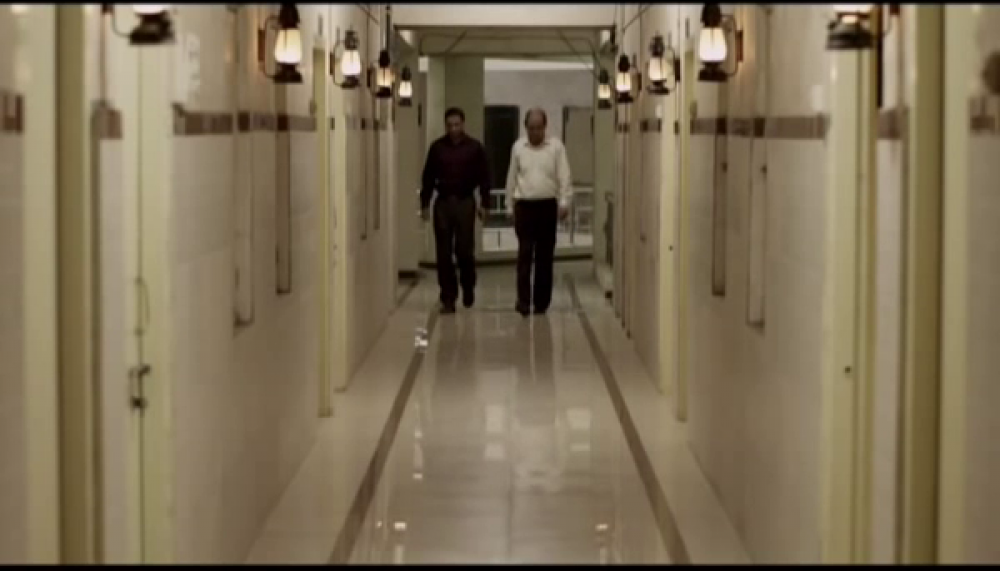
2014 seems to be the year of the “movie-within-the-movie” narrative as a form of cinematic storytelling. A few weeks back, Karthik Subbaraj’s acerbic-yet-entertaining masterpiece, Jigarthanda, critiqued and demystified contemporary Tamil cinema on multiple fronts. And this week, we have Chotushkone, Srijit Mukherji’s sixth film, that uses the same concept to tell a tale of love and betrayal.
Chotushkone is a highly-polarizing film. Regardless of how much money it makes for Reliance Entertainment and Dag Creative Media, it is bound to provoke a lot of debate. During the 3.10 pm show today at INOX City Centre Siliguri, the first half provoked mixed reactions. Some people hated the slow, languorous and disjointed first half, and therefore walked out of the auditorium within the first 30-40 minutes; others loved it and therefore stayed back. The only other Bangla film I remember that elicited this sort of reaction was Q’s Tasher Desh.
Frankly speaking, Chotushkone, just like Jigarthanda, is pretty impossible to review without giving the story away. But there are three ways of looking at the film.
Since Chotushkone revolves around the premise of four directors, each with different cinematic sensibilities, coming together to make four segments of an anthology film, the film is filled with so many references that the discerning film buff would happily lap ’em up. 36 Chowringee Lane, Mr and Mrs Iyer, Troyee, Rupkatha Noy, Ghare Baire, Mayabazaar, Talaash…the list goes on and on. Literary references abound too, with Shakespeare, Kafka and Agatha Christie taking the cake. Parambrata, who plays Jayabrata, one of the directors, makes hilarious digs at his own real-life filmography. I loved that line he uses at a very crucial point in the film–“Ebar ektu hawa-bodol hok!” #win
Then there are the references to Srijit’s own career. Never have we seen so many direct shout-outs to a Bangla filmmaker’s previous films. Besides Autograph, whose shadow looms large over this film, there are subtle (and not-so-subtle) references to Baishe Srabon, Hemlock Society and Jaatishwar. From a certain angle, Chotushkone may be seen as a deconstruction of his previous films, wrapped as a sly tribute.
Secondly, Chotushkone may be seen as a real-life tale of revenge and destruction masquerading as a collaborative effort of creation. The “movie-within-the-movie” format is used in this regard to propel the story forward, as the creators of celluloid get trapped in a tight real-life web of their own making.
But perhaps it is the third angle that is refreshing. The disjointed narrative of Chotushkone works best as an astute allegory documenting the highs and lows of Bangla cinema. The ego-clashes and romantic relationships between actors, the failed real-life relationships of directors in love with their own work, fly-by-night producers (or “chit fund producers” as everyone now knows them as), producers who fell prey to the tantrums of their lead actors, conflicting sensibilities among filmmakers and actors alike—nothing is sacred in Chotushkone. In that sense, this feels like a refreshing and in-your-face reboot of Autograph. The scary part is that we see those realities in Bangla cinema even today.
There are some flaws in this story. The revenge angle is set up beautifully, but I feel Srijit gives the game away about 10 minutes too early. The Payel-Indrasish-Rahul track should have been more seamlessly integrated with the main story. The sub-plot involving Koneenica and Anindya Chatterjee could have been fleshed out more. And Barun Chanda’s presence in the film is similar to that of Pankaj Kapur in Finding Fanny—he’s good in that limited screen-time, but even when he’s not there in the film, you don’t miss him.
Still, these are minor glitches in a film that is technically top-notch. Sudeep Chatterjee, whose previous credits as DoP include Chak De India and Dhoom 3, is in crackling form here, as he runs riot with the color scheme of the film. Reds, blues, greens and monochrome are interspersed freely with a muted palette. Anupam Roy’s score is expectedly good, with Boba tunnel, Bawshonto eshe gechhe and Shetai satyi used in the film.
Doing a film like this requires a tremendous amount of guts, and it is to Srijit’s credit that, in spite of that middling second act, he pulls it off. Of course he has a hugely talented cast helping him here. Parambrata, Aparna Sen and Goutam Ghose are expectedly excellent. Neel Mukherjee, Arpita Chatterjee, Debleena Dutt, Sumit Samaddar, Shantilal Mukherjee and Tridha are all excellent in their brief screen-time. Anindya Chatterjee, whom I had last seen in Bapi Bari Jaa, is good as Dipto’s son. Kaushik Ganguly knocks it out of the park in that cameo. And Koneenica Banerjee shines in that Boba tunnel sequence, where her eyes and body language convey so much, even with brief dialogues.
But if somebody has to be anointed the Man of the Match in this film, it has to be Chiranjeet Chakraborty. As Dipto, the alcoholic actor-turned-director, who shares a difficult relationship with his son, and still harbours feelings for Aparna Sen’s Trina, he shows remarkable restraint—a far cry from his “bou harale bou paoa jaayre” days. I really hope he gets more roles like this in the near future.
Chotushkone is a refreshingly original ode to Bangla cinema. Like Bhooter Bhobishyot, this is a film that would be ruined if remade in another language. However, it’s a polarizing film not many would love. If you want to see something that breaks all conventions of storytelling and is entertaining as hell, go for it.
